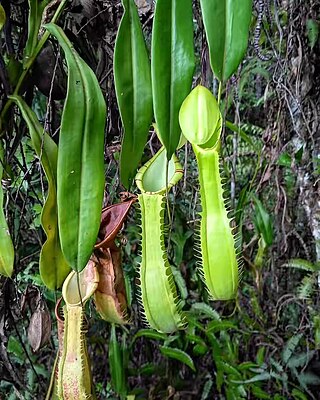
Linaceae is a family of flowering plants. The family is cosmopolitan, and includes about 250 species in 14 genera, classified into two subfamilies: the Linoideae and Hugonioideae. Leaves of the Linaceae are always simple; arrangement varies from alternate to opposite or whorled. The hermaphroditic, actinomorphic flowers are pentameric or, very rarely, tetrameric.
Muricococcum is a genus of plant of the family Euphorbiaceae first described as a genus in 1956. It contains only one known species, Muricococcum sinense, native to southern China and northern Vietnam.

Caspar Georg Carl Reinwardt was a Prussian-born Dutch botanist. He is considered to be the founding father of Bogor Botanical Garden in Indonesia.

Reinwardtia indica, yellow flax or pyoli, is a species of Linaceae found in the Himalayas. It is the only species in the monotypic genus Reinwardtia.
Jumaat Haji Adam is a botanist and taxonomist specialising in the carnivorous pitcher plant genus Nepenthes.
Calonectria ilicicola is a fungal plant pathogen in the family Nectriaceae. It has been found to cause leaf spot in holly, root rot in blueberry, red crown rot in soybean, a root and crown rot of anthurium, and a soft rot of ginger.

The black hornbill is a species of bird of the hornbill family Bucerotidae. It lives in Asia in Brunei Darussalam, Indonesia, Malaysia, Singapore, Thailand.

Nepenthes naga is a tropical pitcher plant endemic to the Barisan Mountains of Sumatra. It is characterised by a forked sub-apical appendage on the underside of the lid and an undulate lid margin. The specific epithet naga is the Indonesian word for "dragon" and refers to the distinctive lid appendage of this species as well as the large size of its pitchers. The name also references local folklore, which tells of dragons occurring in this species's habitat in the past.

Durian Burung is a small border town in Mukim Batang Tunggang Kiri, Padang Terap District, Kedah, Malaysia. Across the border is Ban Prakop of Songkhla, Thailand.
Koordersiochloa is a widespread genus of plants in the grass family, native to Africa, tropical Asia, and various islands in the Indian Ocean.
Johannes Hendrikus Kern (1903–1974) was a Dutch botanist, with an international reputation as an expert on the Cyperaceae.
Oxyceros is a genus of climbing flowering plants in the tribe Gardenieae of the family Rubiaceae. The 12 species are native to Asia from Sri Lanka to Malesia.
Ulu Telupid Forest Reserve is a protected forest reserve in Tongod District of Sandakan Division, Sabah, Malaysia. First established in 1972, it was designated as a Class 1 Protection Forest by the Sabah Forestry Department in 1984. Its area is 6,460 hectares (64.6 km2), down from its former size of 7,508 hectares (75.08 km2). Prior to being established as a forest reserve, the area was used for logging and palm oil plantations. The reserve is mostly mountainous, consisting mainly of mixed dipterocarp forest. The land surrounding the reserve includes a town, oil palm plantations, rubber plantations, and rice paddies. It is threatened by fires and illegal logging. In some areas agricultural activities have encroached into the protected area. Since 2000 there has been a net loss of just under 2% of the reserve's forested area. There is a small level of ecotourism activity in the reserve, consisting of guided tours from a nearby village, which provides livelihood alternatives to logging and poaching.
Papuodendron is a genus of flowering plants belonging to the family Malvaceae. In 1946 Cyril Tenison White described its first species, Papuodendron lepidotum, which was discovered growing in 1944 in the Mandated Territory of New Guinea. Its native range is New Guinea.
Durio macrantha is a species of durian.

Nepenthes longiptera is a tropical pitcher plant endemic to the province of Aceh in the island of Sumatra in Indonesia. Nepenthes longiptera differs from all other Nepenthes species from Sumatra by the presence of wings on its upper pitchers. Morphologically, this species closely resembled N. tobaica, but differs on its much larger habit, the well-developed wings of its upper pitchers, the rhomboid-shaped cross-section of the stem, and the presence of appendage under the lid.
Rafflesia meijeri is a species of parasitic flowering plant in the genus Rafflesia. It was first described by Harry Wiriadinata and Rismita Sari in 2010. It is known from a single location, Sicikeh-Cikeh, a nature park in North Sumatra.
Rafflesia lawangensis is a species of parasitic plant in the genus Rafflesia. It is exclusively found in Bukit Lawang, a small tourist village in Mount Leuser National Park, North Sumatra, Indonesia. Previously misidentified as Rafflesia arnoldii, photographs taken in 2005 led to the eventual separation of Rafflesia lawangensis as a distinct species in 2010.
Nepenthes harauensis is a tropical pitcher plant endemic to the Harau region of West Sumatra. Nepenthes harauensis is closely allied in its morphology to N. bongso and N. singalana, however, it differs by its leaf characters that is thickly coriaceous and petiolate, elliptic-oblong in shape, and distinctive peltate tendril insertion.






